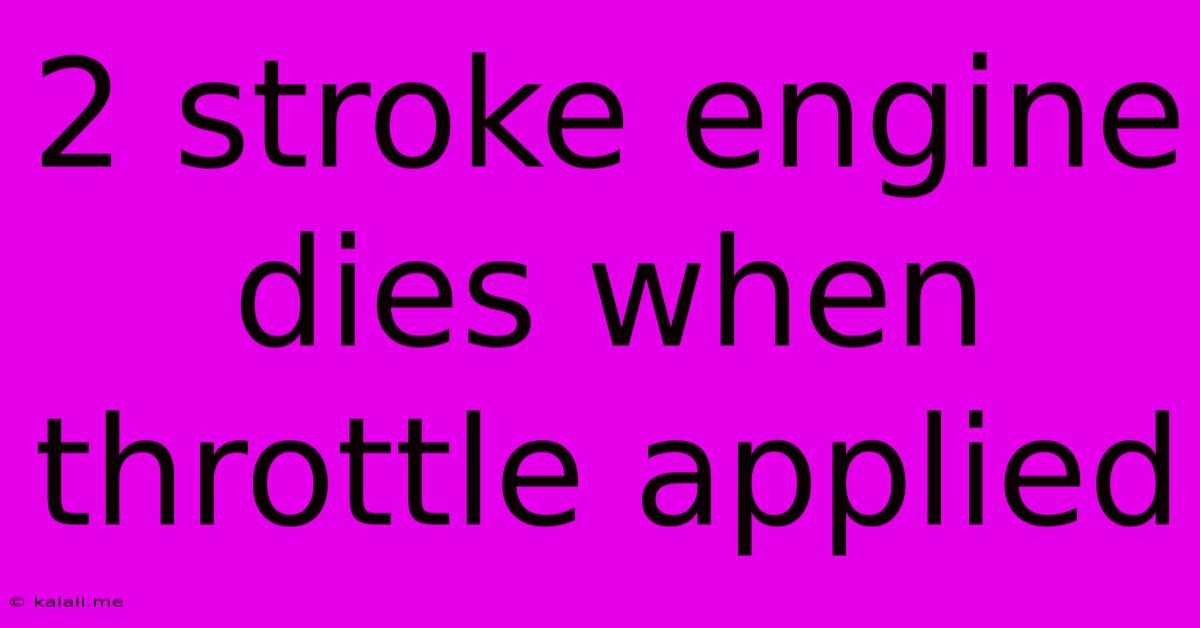2 Stroke Engine Dies When Throttle Applied
Kalali
May 20, 2025 · 4 min read

Table of Contents
2-Stroke Engine Dies When Throttle Applied: Troubleshooting and Solutions
A frustrating problem for any 2-stroke engine owner is when the engine dies as soon as you apply the throttle. This isn't simply a case of a weak engine; it indicates a specific problem preventing the engine from receiving the necessary fuel-air mixture under load. This article will guide you through troubleshooting and resolving this common issue, covering everything from fuel delivery to ignition systems.
Understanding the Problem: A 2-stroke engine relies on a precise mixture of fuel and air to run. When you increase the throttle, you demand more fuel and air. If the engine dies under this increased load, it suggests a blockage, malfunction, or improper mixture preventing the engine from receiving the necessary fuel-air mix to support the higher RPMs.
Common Causes and Troubleshooting Steps:
1. Fuel System Issues:
- Clogged Fuel Line or Filter: A restricted fuel flow will severely limit the engine's ability to handle increased throttle. Inspect your fuel line for kinks, cracks, or blockages. Similarly, check and clean or replace the fuel filter if necessary. A dirty fuel filter is a frequent culprit.
- Fuel Pump Malfunction (if equipped): Some 2-stroke engines use fuel pumps. If yours does, ensure it's functioning correctly. A faulty pump won't deliver enough fuel at higher RPMs.
- Carburetor Problems: This is often the primary suspect. Several carburetor-related problems can lead to this issue:
- Clogged Jets: Small jets in the carburetor can become clogged with dirt or varnish. Cleaning or replacing these jets is crucial.
- Incorrect Fuel Mixture: The carburetor might not be delivering the correct fuel-air ratio. This often requires adjustment or professional cleaning.
- Diaphragm Issues: A damaged or worn carburetor diaphragm can disrupt fuel delivery, especially under load. Replacement might be needed.
- Air Leaks: Air leaks in the carburetor or intake manifold will lean out the fuel mixture and cause the engine to stall under load. Inspect for cracks and ensure a tight seal.
2. Ignition System Problems:
- Weak Spark Plug: A weak or faulty spark plug can struggle to ignite the fuel-air mixture, especially when the engine is demanding more fuel under throttle. Check the spark plug for fouling (black or wet) or damage, and replace if necessary. Test the spark's strength using a spark tester.
- Faulty Ignition Coil: The ignition coil is responsible for generating the high voltage spark. A failing coil will produce a weak or intermittent spark, leading to the engine dying under load.
- Wiring Issues: Loose, damaged, or corroded wiring in the ignition system can disrupt the spark. Inspect all wiring connections carefully.
3. Air Intake Restrictions:
- Clogged Air Filter: A severely restricted air filter will starve the engine of air, creating a lean fuel mixture and causing it to die under load. Check and clean or replace the air filter regularly.
- Intake Manifold Restriction: Check the intake manifold for any blockages or restrictions.
4. Other Potential Issues:
- Low Compression: Low compression will prevent the engine from building enough power to handle increased throttle. This requires a compression test to diagnose.
- Seized Components: Check for any seized or binding components that might be restricting movement and causing the engine to stall.
Addressing the Problem: A Step-by-Step Approach
- Start with the Simplest: Begin by checking the fuel lines, filter, and air filter – these are the easiest to access and often the culprits.
- Inspect the Carburetor: Carefully examine the carburetor for any visible issues. Cleaning is often sufficient, but sometimes replacement might be necessary.
- Check the Spark Plug: A quick spark plug check and replacement can resolve the issue easily.
- Test for Compression (if other steps fail): Low compression indicates a more serious problem requiring professional attention.
- Seek Professional Help: If you've exhausted the troubleshooting steps above, it's time to consult a qualified small engine mechanic.
By methodically addressing these potential problems, you should be able to pinpoint the reason why your 2-stroke engine dies when the throttle is applied and get it running smoothly again. Remember safety precautions when working with small engines and fuel. Always disconnect the spark plug before performing any maintenance.
Latest Posts
Latest Posts
-
How Can I Separate Two Glasses Stuck Together
May 20, 2025
-
How Do I Find The Speed Limit On A Road
May 20, 2025
-
How Do You Pronounce Hermione Granger
May 20, 2025
-
Why Do I Have A Boiler And Hot Water Tank
May 20, 2025
-
Are Jewish People Buried Standing Up
May 20, 2025
Related Post
Thank you for visiting our website which covers about 2 Stroke Engine Dies When Throttle Applied . We hope the information provided has been useful to you. Feel free to contact us if you have any questions or need further assistance. See you next time and don't miss to bookmark.